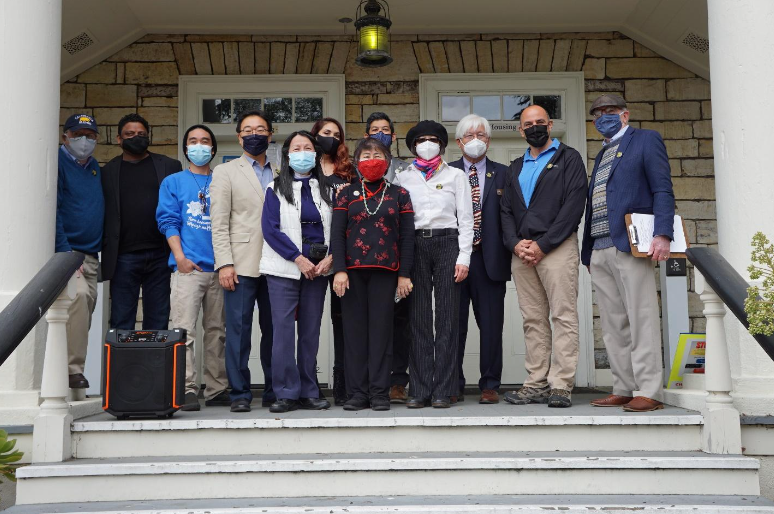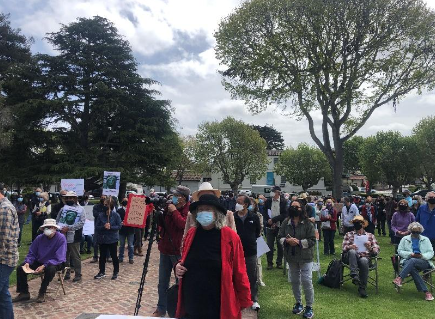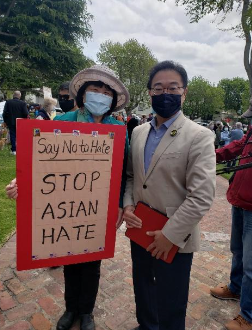Special APIDA Issue's Introduction

Stop AAPI Hate Rally in Monterey | Photo by Yuan Tao
May 3, 2022
Asian Pacific Islander American Heritage Month is upon us, and this special issue of Diverse Perspectives is our attempt to capture some of the diversity, energy, and history of the community. Our three editors—Angie Ngọc Trần, Phương Nguyễn, and Chrissy Lau—hail from different backgrounds, but share an abiding interest in spotlighting our many voices and histories. They found many willing participants and learned a great many things.
Asians have lived in the Monterey region since the mid-1800s. The Chinese arrived shortly after the Gold Rush, making a name for themselves here by harvesting squid and abalone. When the Chinese Exclusion Act of 1882 slowed down the flow from Guangdong, it didn’t take long for Japanese to fill the same niche in fishing and agriculture. Filipinos would do the same in the 1930s and beyond, though, being poorly paid migrant workers, they had fewer opportunities to build traditional communities and accumulate wealth. These were the three largest Asian groups in this country until the 1970s, when new social attitudes, immigration laws, and global shifts brought in a new wave of immigrants and refugees. Locally, that meant more Filipinos affiliated with nursing and the Navy, more South Asians in healthcare and hospitality, Koreans making themselves visible in the number of churches and markets, Vietnamese whose presence on fishing boats and nail salons was undeniable, as well as their collective presence in our public schools as students and teachers. Indeed, Phuong Nguyen was one of those refugees from Vietnam who resettled in Monterey during the 1980s. There are over 18 million Asians in the United States, so many—and from so many different ancestries—that there’s no consensus on the pan-ethnic term to describe us all. There are Asian, Asian American, Asian Pacific American, Asian Pacific Islander, and more. Our editors have adopted another term: APIDA, which stands for Asian-Pacific Islander-Desi Affinity. Please consider this collection of contributions just a small and incomplete sample of a vast and growing community.

Stop AAPI Hate Rally | Photo by Yuan Tao
Part I: Angie Ngọc Trần’s Edited Collection
In reflecting on the more inclusive acronym, APIDA (Asian, Pacific Islander, Desi-Affinity) for this special issue, Dr. Angie Ngọc Trần invited four contributors who demonstrate a range of perspectives and age groups. Angie was very grateful to be able to talk with Ms. MT (pseudonym to protect her privacy), a 74-year old Vietnamese woman, who recently passed the US citizenship exam after being an immigrant for many years; she is candid and passionate about learning and serving others in her community. Dr. Trần also interviewed Palia Vang, a first-gen, non-binary, queer, Asian American (Hmong) Global Studies student whose commitment is to join her community and participate in social movements toward equality, justice, and peace. Furthermore, she was inspired by exchanges with two academics: Mr. Tuyến Nguyễn, a Vietnamese American math professor at Monterey Peninsula College and well-respected leader of the Vietnamese and Buddhist communities in Monterey County and Dr. Ajit K. Abraham, an Desi American professor at CSUMB, who stresses that caste-based discrimination and violence persist not only in contemporary India and across the South Asian diaspora but also in the U.S. Finally, Dr. Trần reflected on her own participation in the Coalition for Asian Justice on the occasion of the one-year anniversary of a very successful Anti-Asian Hate rally that this group organized on April 24, 2021 in front of Monterey City Hall. Together, this collection offers a rich collage of perspectives which may come from different political ideologies but all converge at the desire for social justice, the love for learning and community service, and forms of activism to help marginalized communities such as the “untouchable” or Dalit community.
Part II: Chrissy Lau’s Edited Collection
A Buddhist memoir. A petition with a long list of signatures by white friends and allies. Another petition spearheaded by an Asian American coalition. Dr. Chrissy Lau welcomes contributors who have delved into these artifacts and primary sources that reveal multifaceted stories of racism, survival and solidarity from World War II to the present day in Monterey County. Writer and community organizer, Jean Vengua, reviews the memoir of a forcibly incarcerated Buddhist minister in Salinas during WWII. CSUMB students Amanda Gaffney, Sat Kartar Khalsa, and Christian Rota answer a Q&A with Dr. Lau on the making of their podcast episode on the postwar petition to welcome formerly incarcerated Japanese Americans back to Monterey after WWII. Finally, Dr. Lau interviewed local community organizer and Marina city councilwoman, Kathy Biala, who discusses the culmination of a years-long movement to end the racist Feast of Lanterns festival in Pacific Grove.

Stop AAPI Hate Rally | Photo by Yuan Tao
Part III: Phương Nguyễn’s Edited Collection
Phương Nguyễn invited three contributors to consider the past, present, and future of the APIDA community in Monterey Bay. Former Japanese American Citizens League president Larry Oda spoke about the history of the Japanese community here and his own experience growing up in Monterey since the 1940s. Lifelong teacher Sandy Lydon recalls what it was like researching the history of Chinese in the region, teaching some of the first courses in Asian American history, and working closely alongside the Japanese community. And lastly, up and coming CSUMB faculty member Dr. Jennifer Kuan shares her notes on the Building Community Through Dialogue campus event she organized, an event that brought API voices together, headlined by San Francisco State University professor Dr. Russell Jueng, whose own roots go back to the Point Alones fishing village that was mysteriously burned to the ground in 1906.